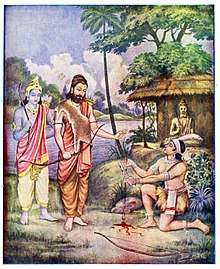Dakshina
Dakshinā, dakṣiṇā, or दक्षिणा), is a Sanskrit word found in Buddhist, Hindu, Sikh and Jain literature where it may mean any donation, fees or honorarium given to a cause, monastery, temple, spiritual guide or after a ritual. It may be expected, or a tradition or voluntary form of daana.[1][2] The term is found in this context in the Vedic literature.[2]
It may mean honorarium to a guru for education, training or guidance.[3]
Etymology and description
According to Monier Williams, the term is found in many Vedic texts, in the context of "a fee or present to the officiating priest (consisting originally of a cow, Kātyāyana Śrautasūtra 15, Lāṭyāyana Śrautasūtra 8.1.2)", a "donation to the priest", a "reward", an "offering to a guru", a "gift, donation".[4]
The word also connotes "south", a cardinal direction.[4] Dakshina is also found in various other expressions such as 'dakshinachara', right-hand path of tantra.[5] The neuter noun dakshinam means 'the Deccan', a transformation of dakshinam as the language evolved.
Gurudakshina

Gurudakshina refers to the tradition of repaying one's teacher or guru after a period of study or the completion of formal education, or an acknowledgment to a spiritual guide.[6] The tradition is one of acknowledgment, respect, and thanks.[7] It is a form of reciprocity and exchange between student and teacher. The repayment is not exclusively monetary and may be a special task the teacher wants the student to accomplish.
Dakshina in Indian epics
There is a symbolic story in the Indian epic Mahabharata that discusses proper and improper gurudakshina, after a character named Ekalavya.[8] This story refers to a tribal boy's passion to learn and master archery.
The story, like many stories in Mahabharata is an open ended parable on education, personal drive to learn, and what is proper and improper dakshina? In the epic Mahabharata, after the right hand thumb as gurudakshina event, Drona is haunted and wonders if demanding Ekalavya's thumb was proper,[9] Ekalavya goes on to re-master archery with four fingers of his right hand, as well as left hand, thereby becoming a mighty warrior, becomes accepted as a king, and tells his children that education is for everyone and that no one can close the doors of education on any human being.[10][11]
See also
- Guru-shishya tradition
References
- James Egge (2013). Religious Giving and the Invention of Karma in Theravada Buddhism. Routledge. pp. 21, 33, 74, 84–86. ISBN 978-1-136-85915-1.
- Maria Heim (2004). Theories of the Gift in South Asia: Hindu, Buddhist and Jain Reflections on Dana. Routledge. pp. 118–120. ISBN 1-135-87851-X.
- Mahendra Caturvedi, A practical Hindi-English dictionary=utf8
- Monier-Williams Sanskrit-English Dictionary ; Quote: f. Donation to the priest (personified along with Brahman2as-pati ब्रह्मणस्-पति, Indra इन्द्र, and Soma सोम, i, 18, 5; x, 103, 8; authoress of x, 107 RAnukr.; wife of Sacrifice [Ragh. i, 31 BhP. ii, 7, 21], both being children of Ruci रुचि and A1ku1ti आकूति, iv, l, 4 f. VP. i, 7, 18 f.); f. reward RV. viii, 24, 2I; f. (offered to the Guru गुरु) MBh. v Ragh. v, 20 Katha1s. iv, 93 f.; f. (˚णाम् आ- √दिश्, "to thank" DivyA7v. vii, 104; Caus. "to earn thanks", i); f. a gift, donation (cf. अभय-, प्रा*ण-) Mn. iii R. ii;

- Bhattacharya, N. N. History of the Tantric Religion. Second Revised Edition. Manohar Publications, Delhi, 1999. ISBN 81-7304-025-7
- गुरुदक्षिणा, Gurudakshina English-Sanskrit Dictionary, Spoken Sanskrit, Germany (2010)
- Radhakrishnan, L. J., & Rabb, H. (2010). Even in nephrology, gurudakshina is important, Kidney International, 78, 3-5
- Kakar, S. (1971). The Theme of Authority in Social Relation in India. The Journal of Social Psychology, 84(1), 93-101
- Kumar, S. THE MAHABHARATA. HarperCollins Publishers India (2011), ISBN 978-93-5029-191-7
- Brodbeck, S. (2006). Ekalavya and Mahābhārata 1.121–28, International Journal of Hindu Studies, 10(1), 1-34
- Brodbeck, Simon (2004) 'The story of Ekalavya in the Mahabharata.' In: Leslie, J. and Clark, M., (eds.), Text, belief and personal identity: creating a dialogue, ISBN 9780728603639